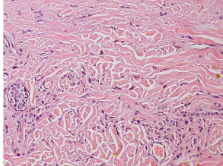Dermis, Hypodermis, and Pigmentation
1/19
There's no tags or description
Looks like no tags are added yet.
Name | Mastery | Learn | Test | Matching | Spaced |
|---|
No study sessions yet.
20 Terms
Papillary layer
Characterized by these hill-like shapes

Reticular layer

What tissue is the papillary layer of the dermis made of?
Areolar CT
What types of cells are present in the papillary layer?
small blood vessels
phagocytes
lymphatic capillaries
nerve fibers
touch receptors
Which layer makes contact with the epidermal layer called the stratum basale?
the papillary layer
What tissue is the reticular layer primarily made of?
Dense Irregular CT
The reticular layer is made of what kind of fibers?
elastin and collagen
The hypodermis, or the subcutaneous layer or superficial fascia, connects the dermis to what other body parts?
The underlying fascia of the bones and muscles
What tissue is the hypodermis primarily made of?
Adipose
How is fat stored in the hypodermis?
Fat is stored as cells called adipocytes, which serve as an energy reserve, insulation, and a cushion.
What three pigments influence skin color?
melanin
carotene
hemoglobin
Melanosome
intracellular vesicle that transfers melanin from melanocytes into keratinocytes of the epidermis
Melanocyte
cell found in the stratum basale of the epidermis that produces the pigment melanin
what are the two forms of melanin pigment?
eumelanin
pheomelanin
Eumelanin
black/brown
Pheomelanin
red
How does sun exposure lead to darkening of the skin?
Exposure to the UV rays cause melanin to be manufactured and built up in keratinocytes.
This accumulation of melanin in keratinocytes leads to the skin to appear darker.
What are freckles and moles?
Irregular accumulation of melanocytes in the skin
Albinism
results when melanocytes are unable to produce melanin
Individuals appear very pale as a result and are more prone to sunburns and skin cancer
Vitiligo
Results from melanocytes in certain areas losing their ability to produce melanin, possible due to an autoimmune reaction